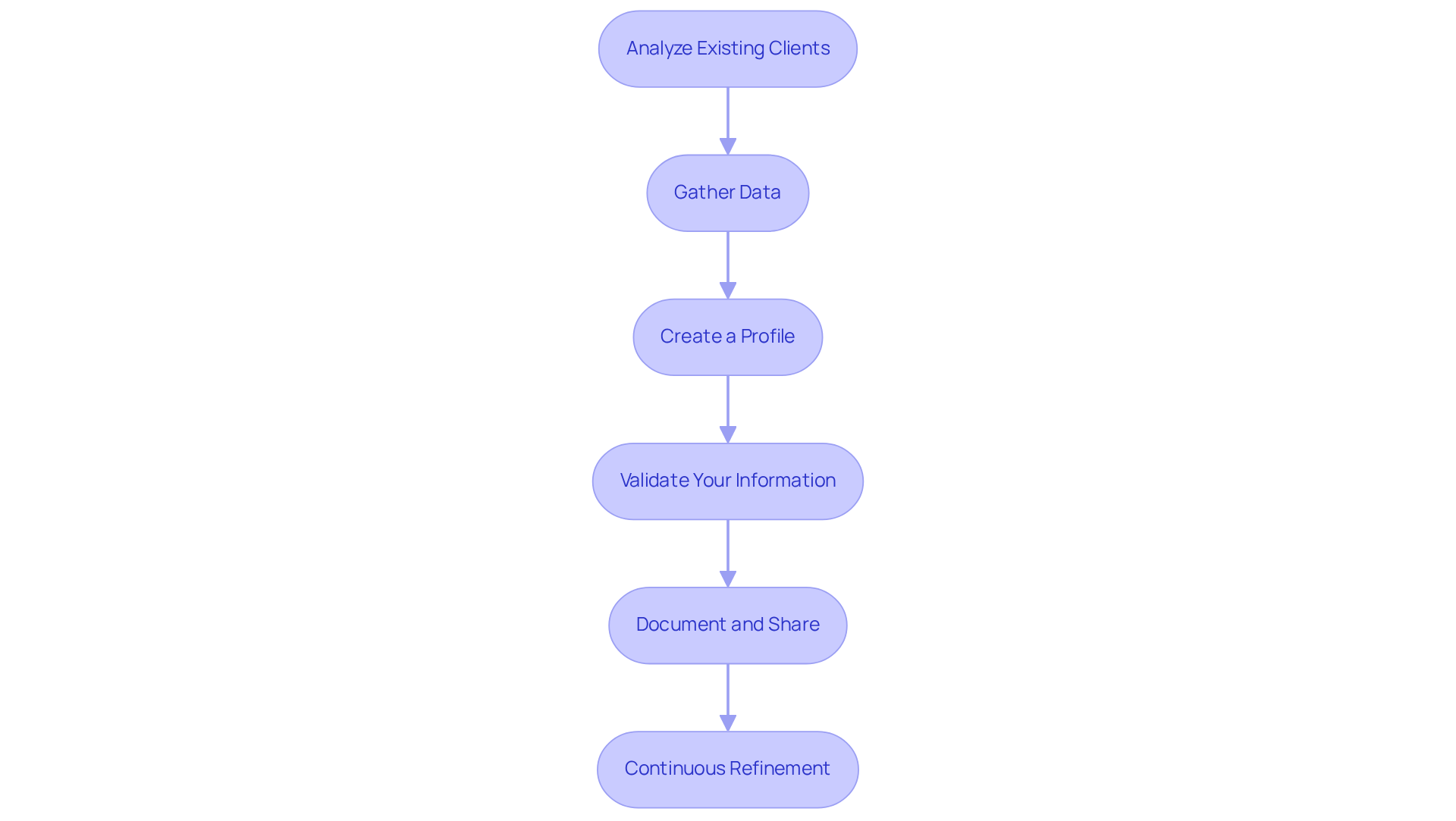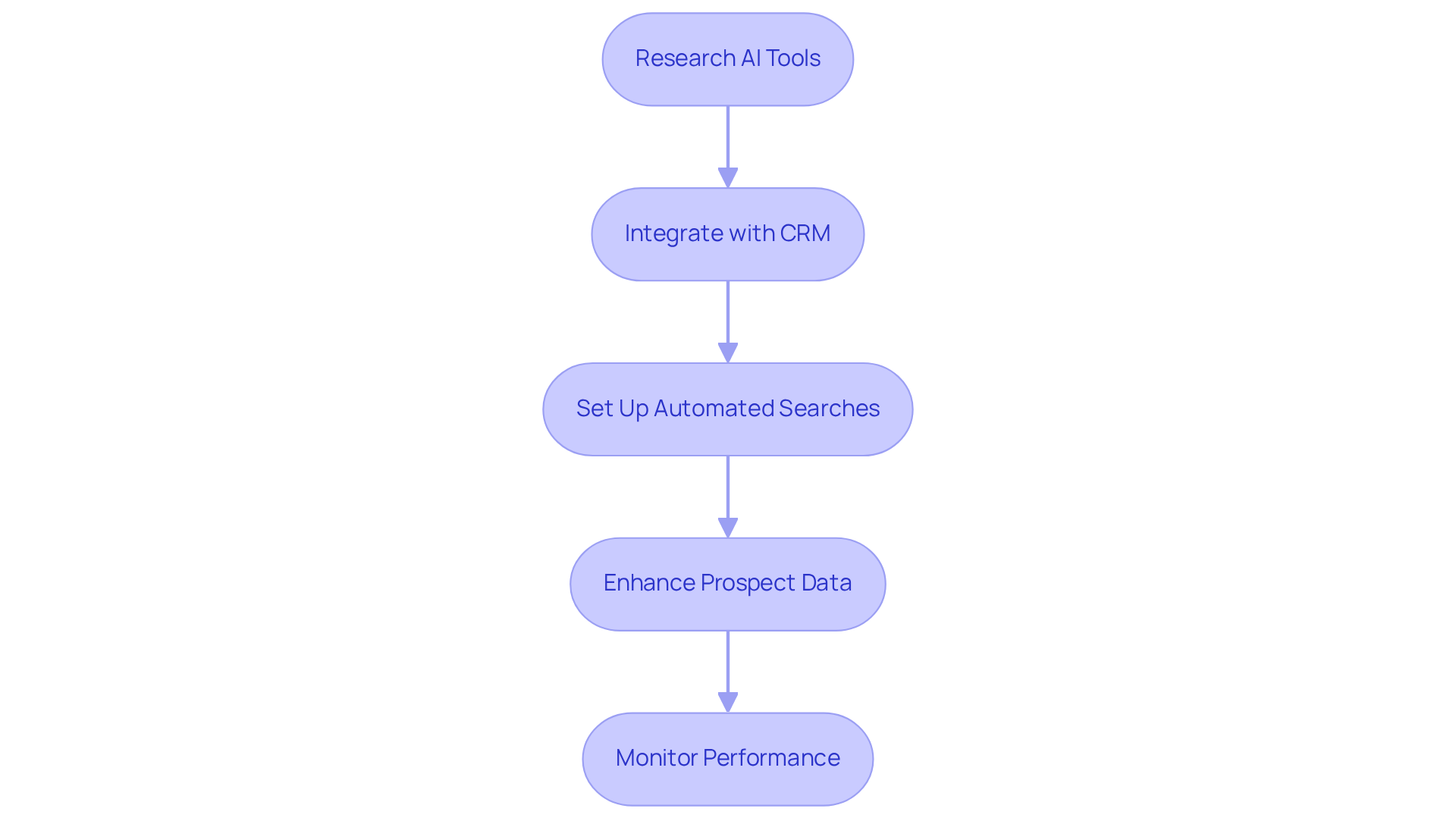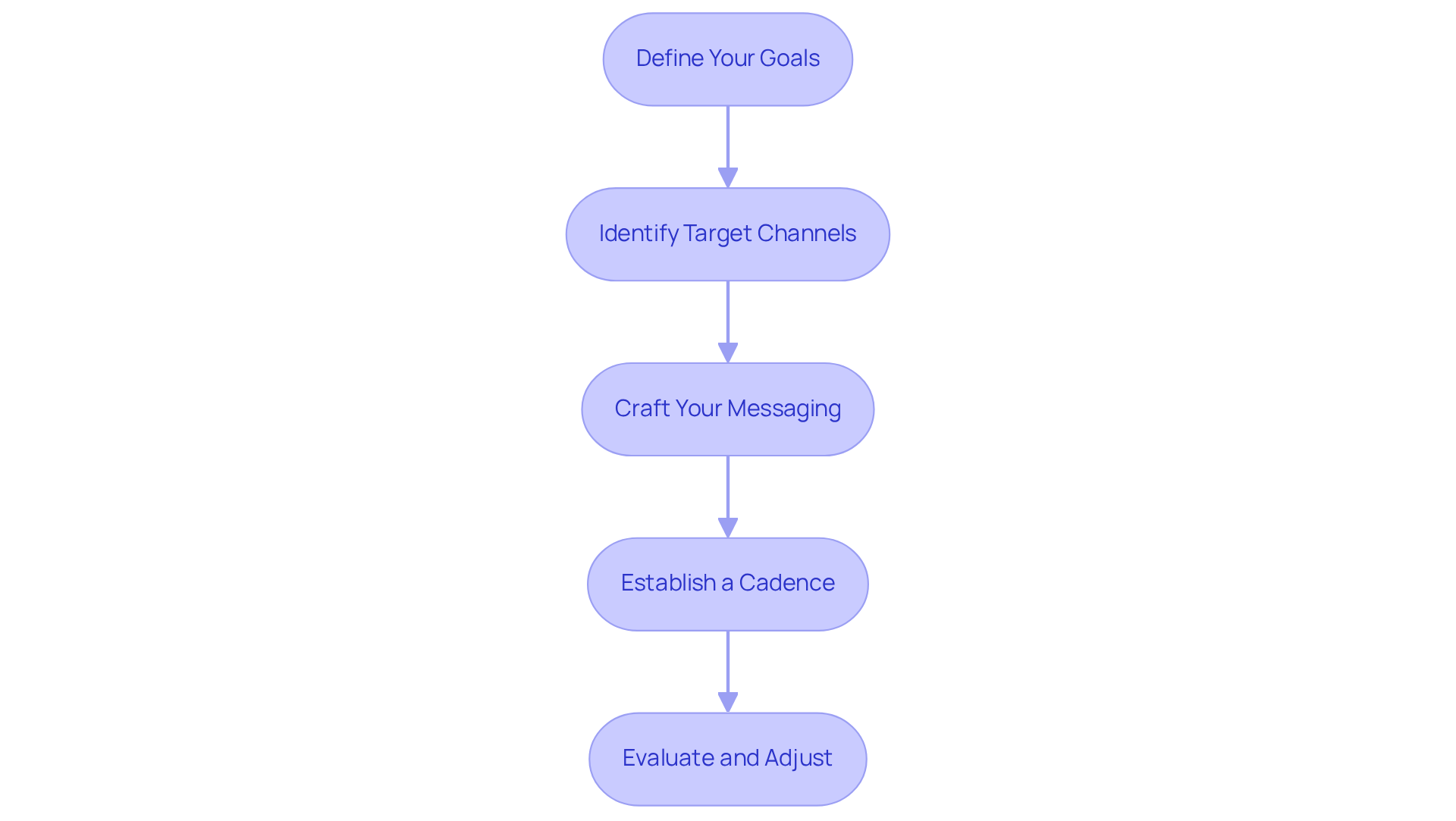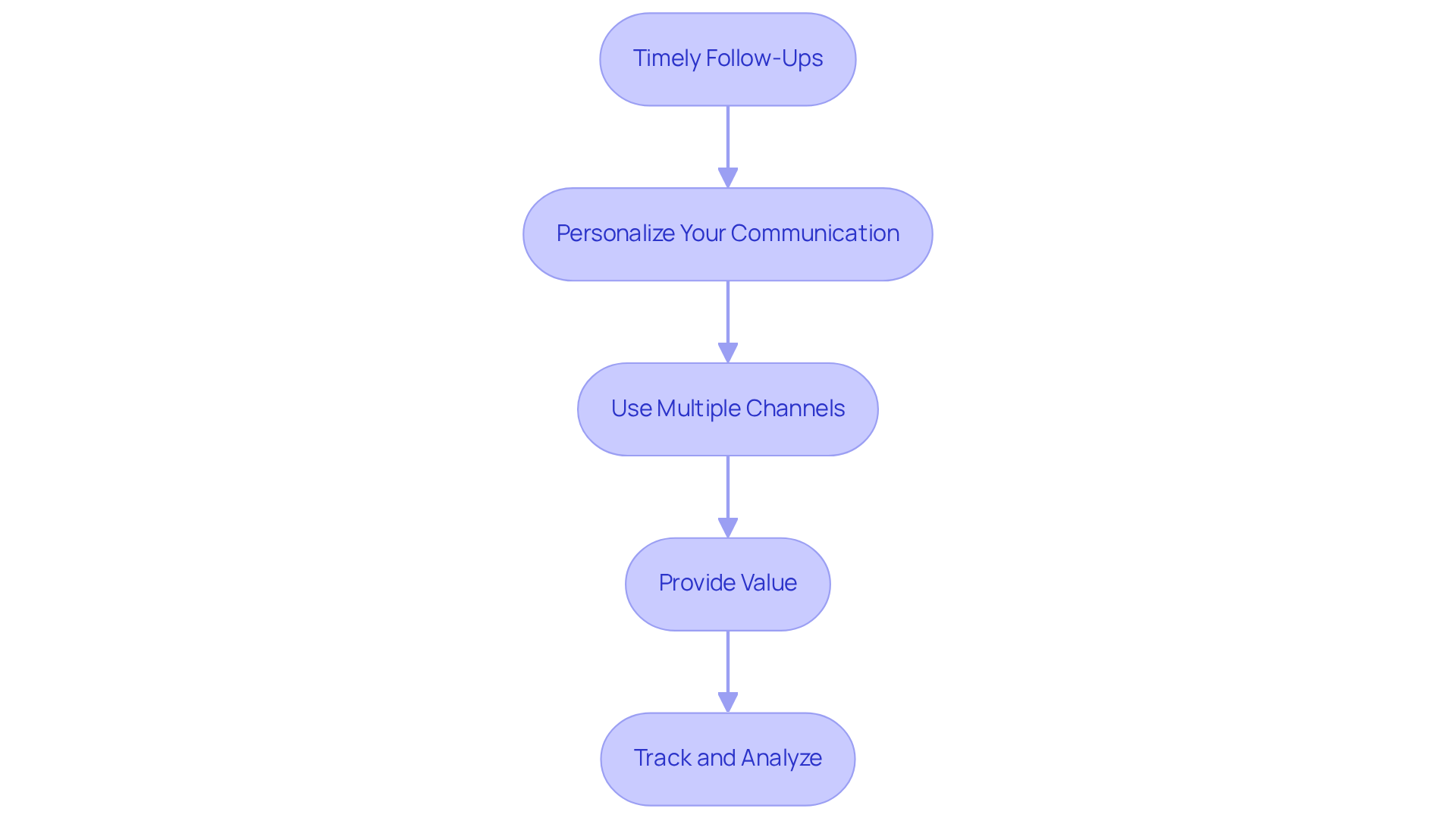Overview
The article delineates four essential steps to amplify your prospect numbers:
- Identifying your ideal customer profile
- Utilizing AI tools for lead generation
- Crafting a strategic outreach plan
- Implementing effective follow-up techniques
Each step is underpinned by data and best practices, showcasing the significance of targeted strategies and ongoing refinement to bolster engagement and conversion rates.
Introduction
In today's competitive marketplace, understanding the intricacies of customer acquisition is more crucial than ever. Businesses aiming to enhance their prospects must navigate a landscape filled with evolving technologies and shifting consumer behaviors. This article explores four essential steps that can significantly boost lead generation and conversion rates. It offers insights into:
- Identifying ideal customer profiles
- Leveraging AI tools
- Crafting strategic outreach plans
- Implementing effective follow-up techniques
Yet, what occurs when traditional methods fall short? How can companies adapt to not only attract but also retain high-quality leads in an increasingly digital world?
Identify Your Ideal Customer Profile
To identify your ideal customer profile, follow these essential steps:
- Analyze Existing Clients: Start by examining your current clientele. Identify common traits among your top clients, such as industry, company size, location, and purchasing behavior. This analysis is crucial—companies that invest in a well-defined ICP can achieve significantly higher conversion rates. Leveraging Websets' AI-driven sales intelligence simplifies this process by providing detailed insights into client demographics and behaviors.
- Gather Data: Utilize analytics tools, including Websets, to collect comprehensive data on client demographics and behaviors. Look for patterns indicating which types of clients are most likely to convert. Recent trends suggest that around 75% of businesses are now utilizing analytics for optimal client profiling, emphasizing its increasing significance in opportunity generation.
- Create a Profile: Develop a comprehensive account encompassing both firmographics (like company size and industry) and psychographics (including values, interests, and challenges). This overview should embody the traits of your perfect client, enabling focused marketing tactics that resonate with the prospects number. Websets can with supplementary information, such as company details and prior interactions, improving your understanding of potential customers.
- Validate Your Information: Test your Ideal Customer Persona by targeting a small segment of prospects that match this description. Monitor the results to determine if they align with your expectations. Modify your account as necessary based on feedback and performance data. Successful examples, such as OffSec's partnership with ViB, demonstrate how refining an ICP can yield a 50% improvement in the quality of prospects and significant ROI. Using Websets' AI-driven insights can further validate your profile by providing real-time data on client engagement.
- Document and Share: Once validated, document your ICP and share it with your sales and marketing teams to ensure alignment in outreach efforts. This collaborative approach enhances engagement and conversion rates, as all team members will be working towards a common goal. Websets facilitates this collaboration by providing a centralized platform for sharing insights and strategies.
- Continuous Refinement: Regularly review and update your ICP to reflect the latest data trends and maintain relevance. This ongoing process is essential for adapting to changes in buyer behavior and market dynamics. With Websets, you can continuously enrich your data and insights, ensuring your ICP remains aligned with market shifts.

Utilize AI Tools for Efficient Lead Generation
To effectively harness AI tools for lead generation, follow these essential steps:
- Research AI Tools: Begin by identifying AI-driven platforms that excel in client acquisition, such as Websets, which leverages advanced algorithms for B2B opportunity discovery. Notably, 75% of businesses are already utilizing or planning to adopt AI-powered tools for improving their prospects number, underscoring the importance of selecting the right platform.
- Integrate with CRM: It is crucial that the AI tools you select can seamlessly integrate with your existing Customer Relationship Management (CRM) system. This integration enhances data flow and management, significantly improving your efficiency in client handling.
- Set Up Automated Searches: Leverage AI tools to automate the search for prospects tailored to your Ideal Customer Profile (ICP). By establishing precise criteria, you can refine outcomes to attract high-caliber prospects that align with your target characteristics, which will greatly enhance your prospects number.
- Enhance Prospect Data: Utilize AI capabilities to with additional insights, including LinkedIn profiles, emails, and company details. This enriched data not only enhances your outreach efforts but also makes your communications more relevant and personalized.
- Monitor Performance: Regularly assess the performance of your AI tools. Examine critical metrics such as conversion rates and engagement levels to gauge their effectiveness. Businesses that have integrated AI into their processes for generating prospects number report a 15% improvement in conversion rates within three months, highlighting the necessity of ongoing evaluation and adjustment.

Create a Strategic Outreach Plan
To create an effective strategic outreach plan, it is essential to follow these key steps:
- Define Your Goals: Clearly outline your objectives, such as increasing the number of qualified leads or securing meetings with potential clients. Setting specific, measurable goals is vital for tracking progress and success.
- Identify Target Channels: Determine the most effective channels for reaching your audience, whether through email, social media, or direct calls. In 2025, average response levels differ greatly by channel, with personalized emails producing higher engagement compared to generic outreach. Tailor your approach based on where your ideal customers are most active.
- Craft Your Messaging: Develop compelling messaging that addresses the pain points and needs of your target audience. Personalization is crucial; leverage insights from your (ICP) to tailor your communication. As Zivko Dodovski emphasizes, buyers prefer solutions over sales pitches. Thus, focusing on how your offering can solve their specific challenges is essential.
- Establish a Cadence: Create a schedule for your outreach efforts, including the frequency of follow-ups and the timing of initial contacts. Consistency is key to maintaining engagement, as ongoing communication fosters familiarity and trust.
- Evaluate and Adjust: After implementing your outreach plan, regularly assess its effectiveness. Collect feedback, evaluate response levels, and modify your strategy as necessary to enhance outcomes. Monitoring key metrics, such as engagement levels and conversion figures, will assist in refining your approach and ultimately improving the prospects number.

Implement Effective Follow-Up Techniques
To implement effective follow-up techniques, consider these steps:
- Timely Follow-Ups: Follow up within 24 hours of initial contact. Research indicates that responding within the first 5 minutes significantly increases the likelihood of converting leads. Prompt responses are essential for maintaining engagement and demonstrating commitment. Businesses that respond within this timeframe are 100 times more likely to connect and convert opportunities.
- Personalize Your Communication: Tailor your follow-up messages based on previous interactions. Citing specific points mentioned demonstrates attentiveness and increases the chance of a reply. Personalized follow-ups can produce a 26% higher response rate compared to generic messages. Furthermore, customization in email follow-ups can positively influence open percentages by as much as 41%.
- Use Multiple Channels: Don’t rely solely on one method of communication. Combining emails, phone calls, and social media messages allows you to reach prospects through their preferred channels, increasing the chances of engagement. High-growth organizations often utilize up to 16 touchpoints over a 2-4 week span to effectively nurture the prospects number.
- Provide Value: In your follow-ups, offer additional insights, resources, or solutions that address the prospect's challenges. This positions you as a helpful partner rather than just a salesperson, fostering trust and increasing the likelihood of conversion. Remember, "The key is to balance persistence with value."
- Track and Analyze: Keep track of your follow-up efforts and analyze their effectiveness. to monitor engagement can help you refine your approach based on what resonates best with different segments of your audience. Companies that analyze their follow-up strategies often see improved response rates and conversion outcomes.

Conclusion
Identifying and understanding your ideal customer profile (ICP) is crucial for enhancing sales effectiveness and boosting prospects. By meticulously analyzing existing clients and leveraging data-driven insights, businesses can develop a targeted approach that resonates with potential customers. The strategies outlined here underscore the necessity of continuous refinement and collaboration between sales and marketing teams to ensure alignment and maximize conversion rates.
Key insights highlight the importance of utilizing AI tools for efficient lead generation. These tools can automate searches and enrich prospect data, ultimately enhancing outreach efforts. Moreover, crafting a strategic outreach plan tailored to specific goals and employing effective follow-up techniques are essential steps in nurturing leads. Such practices not only improve engagement but also build trust and credibility with prospects.
As the landscape of customer acquisition evolves, adopting these essential steps can profoundly impact a business's success. Embracing data analytics, AI technologies, and personalized communication strategies will elevate not only the number of prospects but also position businesses as valuable partners in their clients' journeys. Taking action now to implement these strategies will pave the way for sustainable growth and a competitive edge in the marketplace.
Frequently Asked Questions
What is an Ideal Customer Profile (ICP)?
An Ideal Customer Profile (ICP) is a detailed description of the characteristics of a business's perfect customer, including traits such as industry, company size, location, and purchasing behavior.
How can I identify my ideal customer profile?
To identify your ideal customer profile, analyze existing clients for common traits, gather data using analytics tools, create a comprehensive profile encompassing firmographics and psychographics, validate the information with a small segment of prospects, document and share the profile with your teams, and continuously refine it based on new data.
Why is analyzing existing clients important for identifying an ICP?
Analyzing existing clients helps identify common traits among top clients, which is crucial for creating a well-defined ICP that can lead to significantly higher conversion rates.
What tools can be used to gather data on client demographics and behaviors?
Analytics tools such as Websets can be utilized to collect comprehensive data on client demographics and behaviors, helping to identify patterns that indicate which types of clients are most likely to convert.
What should be included in a comprehensive customer profile?
A comprehensive customer profile should include both firmographics (like company size and industry) and psychographics (including values, interests, and challenges) that embody the traits of your perfect client.
How can I validate my Ideal Customer Persona?
You can validate your Ideal Customer Persona by targeting a small segment of prospects that match the description, monitoring the results, and modifying the profile based on feedback and performance data.
What are the benefits of documenting and sharing my ICP?
Documenting and sharing your ICP with sales and marketing teams ensures alignment in outreach efforts, enhancing engagement and conversion rates as all team members work towards a common goal.
How often should I review and update my ICP?
You should regularly review and update your ICP to reflect the latest data trends and maintain relevance, adapting to changes in buyer behavior and market dynamics.
How can Websets assist in the process of identifying and refining an ICP?
Websets can assist by providing AI-driven sales intelligence, detailed insights into client demographics and behaviors, a centralized platform for sharing insights and strategies, and continuous data enrichment to keep the ICP aligned with market shifts.




